 Autoimmune diseases are a family of more than 80 chronic illnesses. According to the National Institutes of Health, up to 23.5 million Americans, or more than 7 percent of the population, suffer from an autoimmune disease. Autoimmune disorders arise when the body’s immune system, which is meant to protect you from disease and infection, mistakenly attacks healthy cells as if they were invading a virus or bacteria. Autoimmune diseases include arthritis, ulcerative colitis, Crohn’s Disease, Graves’ disease, lupus, Sjögren’s syndrome, and multiple sclerosis. Some other illnesses that commonly affect women such as Fibromyalgia and Chronic Fatigue Syndrome (although not classified as autoimmune diseases) have similar symptoms including fatigue and chronic pain. Common symptoms of autoimmune diseases include chronic joint or muscle pain, extreme fatigue, difficulty sleeping, weakness, nausea, headache, and depression.
Autoimmune diseases are a family of more than 80 chronic illnesses. According to the National Institutes of Health, up to 23.5 million Americans, or more than 7 percent of the population, suffer from an autoimmune disease. Autoimmune disorders arise when the body’s immune system, which is meant to protect you from disease and infection, mistakenly attacks healthy cells as if they were invading a virus or bacteria. Autoimmune diseases include arthritis, ulcerative colitis, Crohn’s Disease, Graves’ disease, lupus, Sjögren’s syndrome, and multiple sclerosis. Some other illnesses that commonly affect women such as Fibromyalgia and Chronic Fatigue Syndrome (although not classified as autoimmune diseases) have similar symptoms including fatigue and chronic pain. Common symptoms of autoimmune diseases include chronic joint or muscle pain, extreme fatigue, difficulty sleeping, weakness, nausea, headache, and depression.
Staying Active Is Important
Many people with an autoimmune disease go through periods of being symptom-free, and then have sudden onset of severe symptoms called flares. It’s understandable that when you’re not feeling well, you may avoid exercise because it’s difficult to find the motivation and energy to be active. For many people with autoimmune disorders, however, moderate low-impact exercise and physical activity can be of tremendous benefit to their quality of life. Keeping active is especially important when you have an autoimmune disease for several reasons: exercise boosts physical energy; endorphin production is a natural painkiller; exercise can help reduce inflammation throughout the body; and exercise also helps combat the depression and anxiety that also often accompany this type of illness.
Exercise Tips for People with Autoimmune Disease
Here are some tips for exercising when you have an autoimmune illness:
- Go at your own pace and figure out what works for you. Not everyone’s experience of autoimmune disease symptoms is the same. Start slowly with your workouts and work your way up to more challenging ones. Some days will be harder than others—adjust your workout accordingly. If you miss a day because of a flare, don’t beat yourself up about it, just make sure you get back to the gym as soon as you can.
- Have good support systems. Talk to your health care providers about your plans to exercise and ask for their input. Make an appointment at your gym to have a fitness assessment with a personal trainer. You may also find it fun and motivating to have a fitness buddy other than your trainer, someone you can attend group classes with, or even just meet a designated time to hit the cardio machines or do weights together.
- Keep a journal of your daily activities, including when you exercise, the activities you did, and what you ate. If you find yourself overly exerted, you will probably see patterns start to emerge when you have the most or least amount of energy. Take these into consideration and adjust your routine to fit you best.
- Give your body the fuel it needs to succeed. You may even want to consider an anti-inflammatory diet. Many autoimmune disorders create inflammation in the body, which leads to muscle and joint pain, as well as fatigue. You can consult with a nutritionist to see whether there are diet changes you can make to help you be successful.
- Rest! Your body may have a hard time adjusting to the workload you are putting it through. Allow yourself to get adequate rest. Remember, this is a lifelong condition that requires lifelong attention.
This blog was written by Emily Lesich, NIFS Health Fitness Specialist. To learn more about the NIFS bloggers, click here.


 Sports careers, whether you are junior varsity or a hall of fame professional, all come to an end at some point. Often, these endeavors are marred with setbacks due to injuries ranging far and wide and sometimes spanning years. During competition and in the spirit of the moment, athletes sometimes push their bodies and minds beyond what was thought possible, resulting in amazing feats—but also potential injuries.
Sports careers, whether you are junior varsity or a hall of fame professional, all come to an end at some point. Often, these endeavors are marred with setbacks due to injuries ranging far and wide and sometimes spanning years. During competition and in the spirit of the moment, athletes sometimes push their bodies and minds beyond what was thought possible, resulting in amazing feats—but also potential injuries.
 Are you looking for a workout to strengthen and tone muscles without increasing bulk, but have not found anything that you like doing? Have you always wanted to increase your cardiovascular endurance and metabolism but hate doing regular old boring cardio? Well I might have an answer for you…
Are you looking for a workout to strengthen and tone muscles without increasing bulk, but have not found anything that you like doing? Have you always wanted to increase your cardiovascular endurance and metabolism but hate doing regular old boring cardio? Well I might have an answer for you…  Cycling is becoming one of the most popular trends in group fitness. Not only is it a great class to take for the cardio benefits and calorie burn, cycling is a great resistance-based workout that can also increase strength. Many cycling classes are tracked in two ways, by
Cycling is becoming one of the most popular trends in group fitness. Not only is it a great class to take for the cardio benefits and calorie burn, cycling is a great resistance-based workout that can also increase strength. Many cycling classes are tracked in two ways, by  This is a great time of year to get out and do some fitness activities that you do not get to do year round, living in an Indiana climate. As the weather turns, the opportunity for some watersports becomes more realistic. While there are many different things you can do for exercise on the water like kayaking, canoeing, and swimming, my all-time favorite outdoor activity is paddleboarding. The benefits of
This is a great time of year to get out and do some fitness activities that you do not get to do year round, living in an Indiana climate. As the weather turns, the opportunity for some watersports becomes more realistic. While there are many different things you can do for exercise on the water like kayaking, canoeing, and swimming, my all-time favorite outdoor activity is paddleboarding. The benefits of